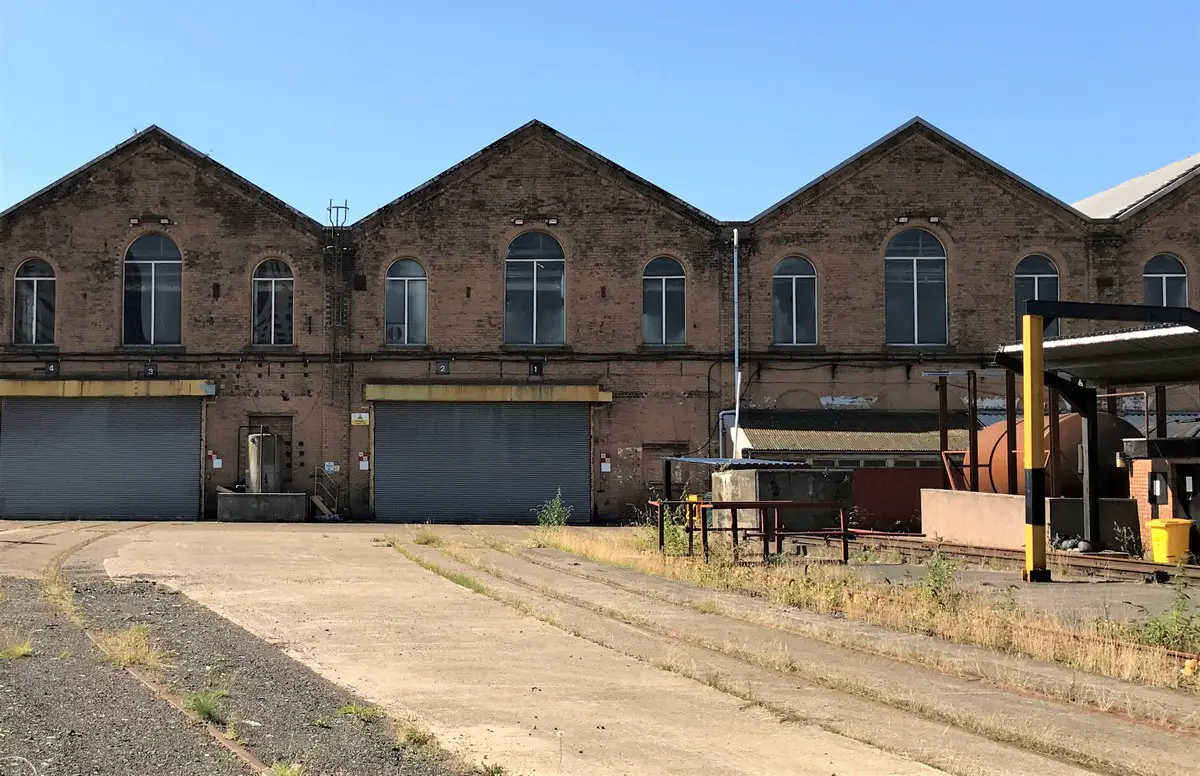St Rollox Locomotive Works Glasgow Building, Springburn Property Design, Historic Environment Scotland, Architect
St Rollox Locomotive Works in Glasgow
post updated 18 May 2022
St Rollox Locomotive Works in Glasgow recognised with listed status
St Rollox Locomotive Works:
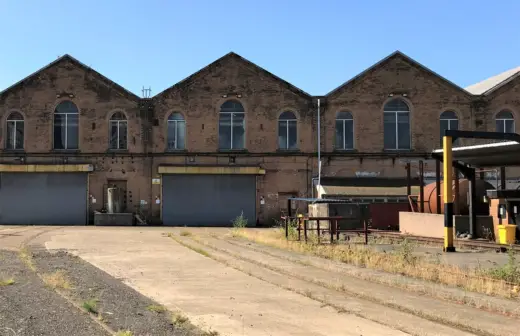
photo © Courtesy of HES
St Rollox Locomotive Works Listing News
Significant piece of city’s industrial heritage listed at Category B
The former St Rollox Locomotive Works in Springburn has been listed at Category B in recognition of its special architectural and historic interest, Historic Environment Scotland (HES) announced today (Wednesday 18 May).
St Rollox Works is significant as a rare surviving example of a late 19th century locomotive works in Scotland and the only surviving example in Springburn, which was once a global centre of locomotive construction.
Built largely in 1882, St Rollox Works was the largest and longest operational locomotive manufacture and repair works in Scotland. It was established and constructed in the Springburn district of Glasgow by the Caledonian Railway Company as their principal locomotive construction and repair works.
It played a significant role in the expansion of the railway on the landscape of Scotland. The St Rollox Works were remodelled by the Caledonian’s newly appointed chief engineer Dugald Drummond to designs by district engineer, Robert Dundas between 1882 and 1887, in response to Caledonian’s need for a much larger works as the rail network rapidly expanded and advances in locomotive engineering, distribution and export were made.
The Caledonian Railway Company was subsumed by the London, Midland and Scottish Railway Company in 1923. Locomotive engine manufacture largely ceased at St Rollox by 1928, although it remained heavily involved in railway vehicle repair and maintenance. At the time of the nationalisation of the railways in 1948, the St Rollox Works continued to employ more than 3300 workers.
The former St Rollox Works were retained in public ownership and continued to operate in service to the railway industry until 2019 when the works were closed and sold to a private owner in 2021. Today the building retains many features which demonstrate its previous function, including its interconnected workshop design of high-quality ironwork.
The designation of St Rollox Works follows a consultation where members of the public were invited to share their views on the special historic and architectural significance of the building.
Dara Parsons, Head of Designations at HES, said: “The former St Rollox Works is a significant piece of Scotland’s industrial and transport heritage, and a worthy addition to the list of Scotland’s special buildings. It made an important contribution to railway history and to Springburn’s role as a major centre for rail manufacture and repair in the 19th and 20th centuries.”
Glasgow, Springburn, St Rollox Locomotive Works. General view from East showing crane and erecting shop exterior (right foreground) and boiler house (extreme left):
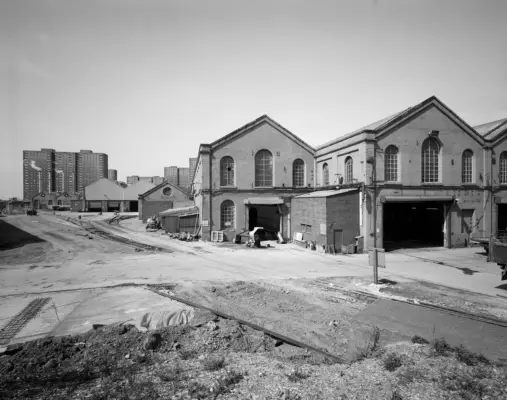
photo © Courtesy of HES
HES lists buildings of special architectural or historic interest that help to create Scotland’s distinctive character, and through which we can discover more about the stories of our past. All designation applications are researched and assessed by a dedicated team.
More information on the decision can be found on the HES website, as well as the listed building record in Scotland.
Previously on Glasgow Architecture:
7 March 2022
HES seeks views on listing of St Rollox Locomotive Works in Glasgow
Significant piece of city’s industrial heritage is considered for listed status
St Rollox Locomotive Works Listing Proposal
St Rollox Locomotive Works could soon be recognised with listed status, as Historic Environment Scotland (HES) announced it is seeking views from the public on proposals to list the former railway works site in Springburn at Category B due to its special historic and architectural interest.
St Rollox Works is significant as a rare surviving example of a later 19th century locomotive works in Scotland and as the only surviving example in Springburn, which was once a global centre of locomotive construction.
Built in 1854-56, and enlarged in 1884-86, St Rollox Works was the largest and longest operational locomotive manufacture and repair works in Scotland. It played a significant role in the expansion of the railway on the landscape of Scotland and was a major employer in Glasgow. The works closed in 2019.
Today the building retains many features which demonstrate its previous function, including its interconnected workshop design of high-quality ironwork and an intact over-head travelling crane system.
Glasgow, Springburn, St Rollox Locomotive Works, interior. View of carriage repair shop:
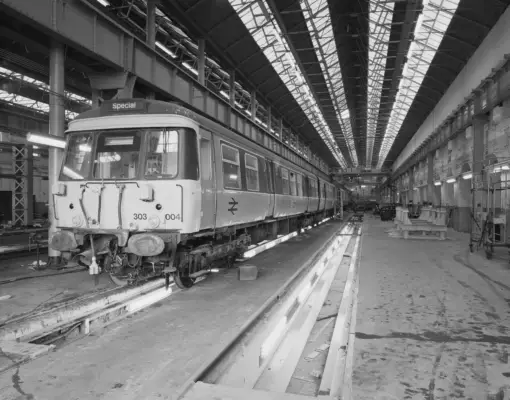
photo © Courtesy of HES
Dara Parsons, Head of Designations at HES, said: “The former St Rollox Works is a significant piece of Scotland’s industrial and transport heritage, contributing to our understanding of Scotland’s railway history and in particular, Springburn’s role as a major centre for rail manufacture and repair in the 19th and 20th centuries. After assessing the site for listing, we are proposing to add it to Scotland’s list of buildings of special architectural and historic interest.
“Listing is a way of recognising and celebrating what makes our built heritage special and ensuring this is taken into account in future decisions. We’re keen that people have an opportunity to have their say as part of this process, so we encourage anyone with an interest in the building to take part in our consultation.”
The consultation will run until Monday 28 March. To find out more and to take part, visit the HES website.
Glasgow, Springburn, St Rollox Locomotive Works, interior. Operating the wheel press in the wheelwrights shop:
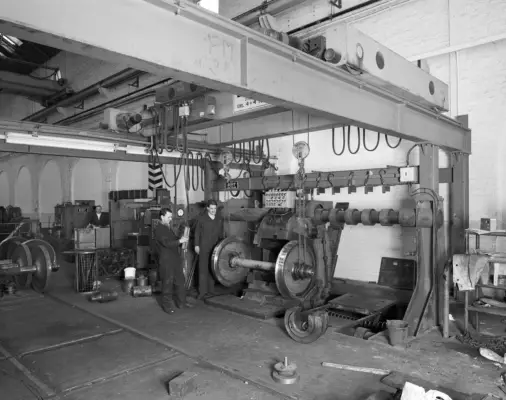
photo © Courtesy of HES
St Rollox Locomotive Works in Glasgow Listing images / information from HES
Architecture in Strathclyde
Glasgow Buildings Selection
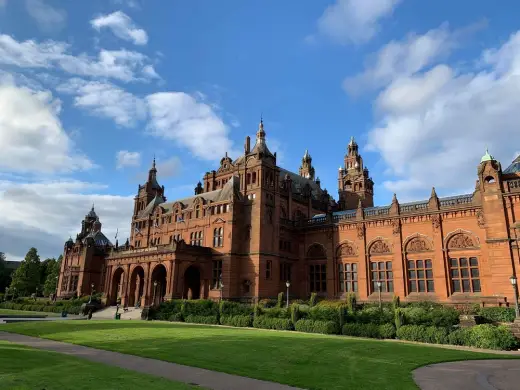
photo © Adrian Welch
Kelvingrove Art Gallery
Comments / photos for the St Rollox Locomotive Works in Glasgow Listing page welcome
